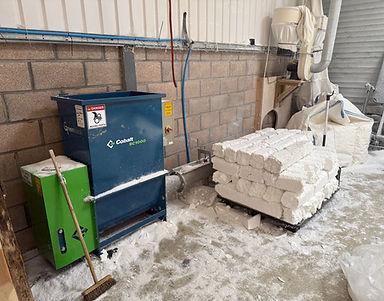
YES, THAT'S RIGHT 100%
Polystyrene is a polymer and consists of only one type of monomer, namely styrene. Styrene is a by-product of oil, which is used for several different types of plastics and not just polystyrene. Did you know that styrene occurs naturally in cinnamon, coffee beans, strawberries and wheat? Raw material producer’s covert the styrene into polystyrene, which is then converted into EPS raw materials. The producers of expanded polystyrene products use steam to heat the EPS beads. This causes the EPS beads to expand into loose foamed EPS beads that are up to 50 times their original volume. So, EPS is made of 98% air.





EPS CYCLE
A circular tour with EPS
New products of EPS can (and do) contain up to 50% regranulated material. Of course, the amount depends on the product itself, since the regranulated pearls do not expand during the moulding process itself.
It starts with recycling in the factory
Even before the EPS leaves the factory, it can be part of circular loops. When the EPS raw material is foamed and shaped, faulty production can occur. For example, packaging can break or otherwise be damaged, while EPS blocks for insulation use are cut and adapted. All the excess EPS is granulated and transformed into loose EPS pearls, which are part of the production of new packaging or insulation.
The next step is mechanical recycling
When an EPS product cannot be reused or if it’s broken, then there are different options. In the EPS industry, members have been taking back EPS from their customers since the eighties and nineties of last century. When the packaging or building waste is pure, it can be regranulated and reused just as with waste and cut off from the original production. The EPS beads can be regranulated a number several times in this way before being recycled by being melted down. The granulation process itself automatically separates EPS beads that cannot be recycled. Many EPS building insulation products contain (much) recycled EPS, mostly from packaging but increasingly also from building applications.
Recycling to PS
However, not all used EPS can be mechanically recycled. If the EPS packaging or building waste is too dirty, it cannot be regranulated and the EPS pearls cannot be recycled directly in production. If possible, the material must then be sent for recycling by melting to (General Purpose) PS. The collected EPS will first be compressed and made into blocks being reprocessed into a new polystyrene regranulated which is compatible and comparable both to a number of virgin GPPS materials as well as other PS recyclables that are used for new products. We often see it used for XPS insulation products.
Other EPS products such as car seat parts and bicycle helmets have a long service life and can be used for years. Once they are worn out (or the bike helmet has mitigated a fall against a curb) the EPS can be collected and recycled. For some EPS packaging, such as packaging for organs or fish boxes, it is not allowed to be mechanically recycled, in which case it will be sent directly for recycling to GPPS.
Other roads
Once the EPS is collected, there are also alternative ways to go. Sometimes EPS is collected for recycling in the production of EPS concrete. The packaging is granulated into several pieces and is included in the production of the material. Since the alternative to recycled EPS is new EPS pearls, it may be the most environmentally appropriate solution, rather than collecting and converting into new EPS raw materials, which must then be foamed into EPS for use with EPS concrete.
Conclusion
Thus, EPS is permanently recyclable, as it can be recycled indefinitely and even EPS that has been contaminated can be cleaned and upcycled into new EPS. And be sure: the EPS industry achieves very high recycling rates


